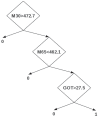Novel algorithm for non-invasive assessment of fibrosis in NAFLD
- PMID: 23638085
- PMCID: PMC3640062
- DOI: 10.1371/journal.pone.0062439
Novel algorithm for non-invasive assessment of fibrosis in NAFLD
Abstract
Introduction: Various conditions of liver disease and the downsides of liver biopsy call for a non-invasive option to assess liver fibrosis. A non-invasive score would be especially useful to identify patients with slow advancing fibrotic processes, as in Non-Alcoholic Fatty Liver Disease (NAFLD), which should undergo histological examination for fibrosis.
Patients/methods: Classic liver serum parameters, hyaluronic acid (HA) and cell death markers of 126 patients undergoing bariatric surgery for morbid obesity were analyzed by machine learning techniques (logistic regression, k-nearest neighbors, linear support vector machines, rule-based systems, decision trees and random forest (RF)). Specificity, sensitivity and accuracy of the evaluated datasets to predict fibrosis were assessed.
Results: None of the single parameters (ALT, AST, M30, M60, HA) did differ significantly between patients with a fibrosis score 1 or 2. However, combining these parameters using RFs reached 79% accuracy in fibrosis prediction with a sensitivity of more than 60% and specificity of 77%. Moreover, RFs identified the cell death markers M30 and M65 as more important for the decision than the classic liver parameters.
Conclusion: On the basis of serum parameters the generation of a fibrosis scoring system seems feasible, even when only marginally fibrotic tissue is available. Prospective evaluation of novel markers, i.e. cell death parameters, should be performed to identify an optimal set of fibrosis predictors.
Conflict of interest statement
Figures



References
-
- Ratziu V, Bellentani S, Cortez-Pinto H, Day C, Marchesini G (2010) A position statement on NAFLD/NASH based on the EASL 2009 special conference. J. Hepatol. 53: 372–384. - PubMed
-
- Feldstein AE (2010) Novel insights into the pathophysiology of nonalcoholic fatty liver disease. Semin. Liver Dis 30: 391–401. - PubMed
-
- Argo CK, Caldwell SH (2009) Epidemiology and natural history of non-alcoholic steatohepatitis. Clin Liver Dis 13: 511–531. - PubMed
-
- Kleiner DE, Brunt EM, Van Natta M, Behling C, Contos MJ, et al. (2005) Design and validation of a histological scoring system for nonalcoholic fatty liver disease. Hepatology 41: 1313–1321. - PubMed
-
- Grønbaek K, Christensen PB, Hamilton-Dutoit S, Federspiel BH, Hage E, et al. (2002) Interobserver variation in interpretation of serial liver biopsies from patients with chronic hepatitis C. J. Viral Hepat. 9: 443–449. - PubMed
Publication types
MeSH terms
LinkOut - more resources
Full Text Sources
Other Literature Sources
Medical
Miscellaneous

